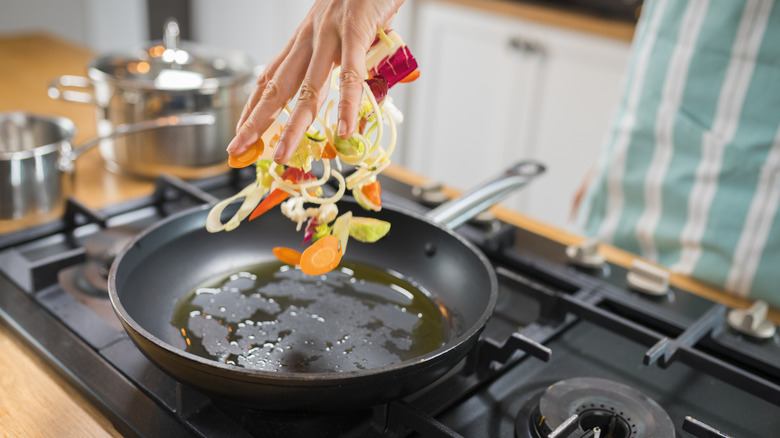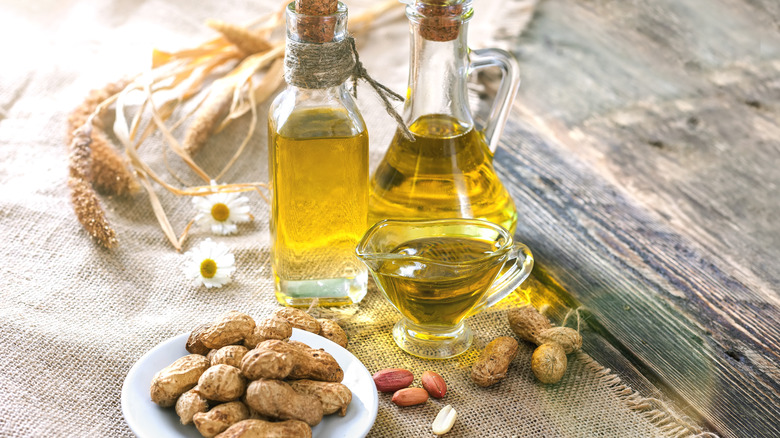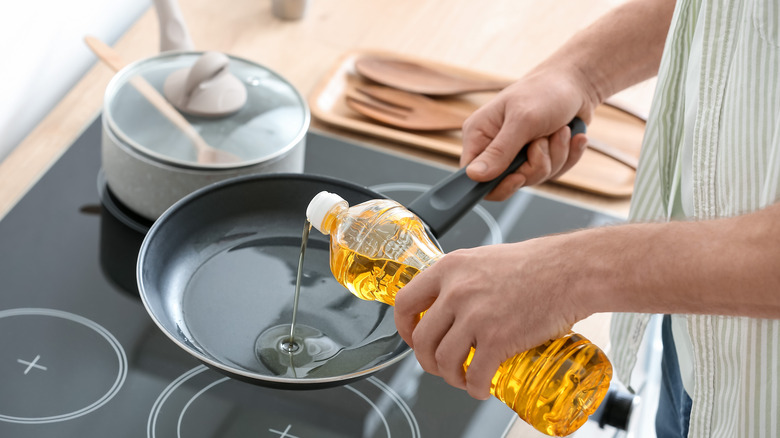The Best High-Heat Oils To Use For A Perfect Sauté
Gone are the days when cooking oil is an afterthought — just a bland liquid to grease the bottom of a frying pan. Professional and home-kitchen cooks know a thing or two about what's actually in that bottle, including where the oil originates and even how hot each one gets before starting to burn. That information has significant effects on how your food tastes as well as nutritional value and health considerations.
When it comes to sautéing on your stovetop, which requires quickly frying foods in a small amount of hot oil, the delicate balance between heat temperatures can make or break an otherwise carefully planned meal. You'll need high-heat cooking oil to create a perfect sauté, determined by what's known as its smoke point. This is basically the temperature at which the oil's internal structure begins to break down, losing its stability and causing it to burn and emit smoke.
After this happens, your food will taste burned — and sometimes bitter — due to the release of acrolein, which can also cause lung issues. But that's only part of the problem. After passing its smoke point, oil begins the process of oxidation, releasing free radicals that could cause cellular damage and lead to diseases in the human body.
Fortunately, quite a few "good" oils have impressive smoke points, making them ideal for cooking methods, such as sautéing, that require exposure to high heat levels.
Best oils for high smoke points
Dozens of cooking oils receive heat ratings based on when they begin to burn and smoke, which typically ranges from 325 to 520 degrees Fahrenheit. Some variation occurs depending on the oil and the manufacturer. Before sautéing food, choose an oil that can withstand the high heat needed for browning and drawing out complex flavors from the ingredients. You'll be adding it to a preheated pan, so the oil will quickly start to shimmer when ready.
Generally, high-heat oils tolerate temperatures of 400 degrees and up. Two oils with the highest heat tolerances are refined avocado oil and safflower oil, both with smoke points above 500 degrees. Oils in the 450-degree range include sunflower, peanut, soybean, rice bran, corn, sunflower, and refined coconut, followed by those in the roughly 400-degree range such as refined sesame oil, canola oil, and the generically named "vegetable oil" ranging from 400 to 450 degrees.
Olive oils have a wider spectrum, depending on processing. The highest heat tolerance of about 465 degrees comes with light olive oil, which refers to flavor rather than calories. It has been refined for a lighter taste, an alternative to the somewhat strong flavor of other olive oils.
Extra virgin olive oil has a considerably lower smoke point of 325 to 375 degrees and works best in cold applications. The same goes for virgin and unrefined avocado oils, which burn at about 375 degrees, compared to the refined versions at 520 degrees.
Refined versus unrefined oils
Many oils used for cooking go through extra processing, landing them in the category of refined oils. These tend to have higher smoke points, which work well when sautéing ingredients. They tend to have more neutral, consistent flavors than those left in their "virgin" state, extracted by pressing, mashing, or expelling oils from the vegetable, fruit, seed, or nut using little — if any — heat.
The refining process helps cooking oils withstand high heat by removing volatile compounds that break down during the cooking process. To remove them, the oil is subjected to heat, filtering, and bleaching, sometimes using chemical solvents, which is a concern for some people. In addition to the higher smoke points, they typically have a longer shelf life and more reliable taste.
Unrefined oils, on the other hand, retain their natural, earthy flavors and colors, as well as nutritional value. You'll notice labels with terms like unrefined, virgin or extra-virgin, cold-pressed, or unprocessed. They may appear cloudy compared to refined versions, and they generally last a shorter amount of time in your pantry. They're an excellent choice for dressings, unheated sauces, focaccia bread dips, or drizzles for vegetables and meats.
One final consideration for creating a perfect sauté is butter — but not in its standard form, which carries a low smoke point of only about 300 degrees. However, using clarified butter or ghee, which withstands heat up to 450 degrees, imparts a warm, nutty flavor to any dish without overpowering other ingredients.



